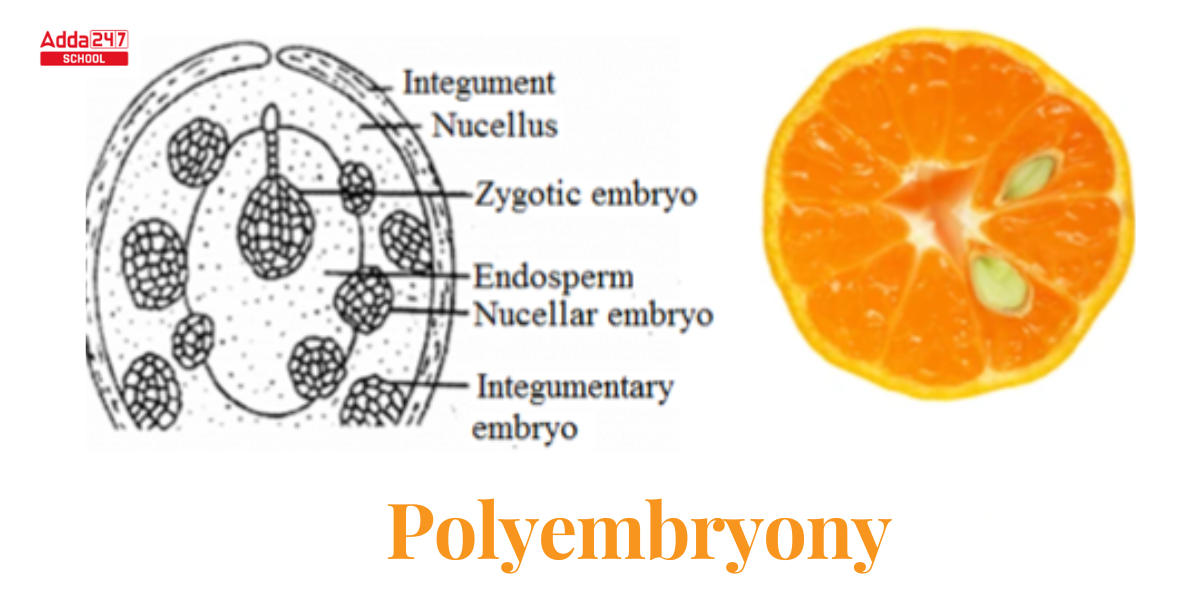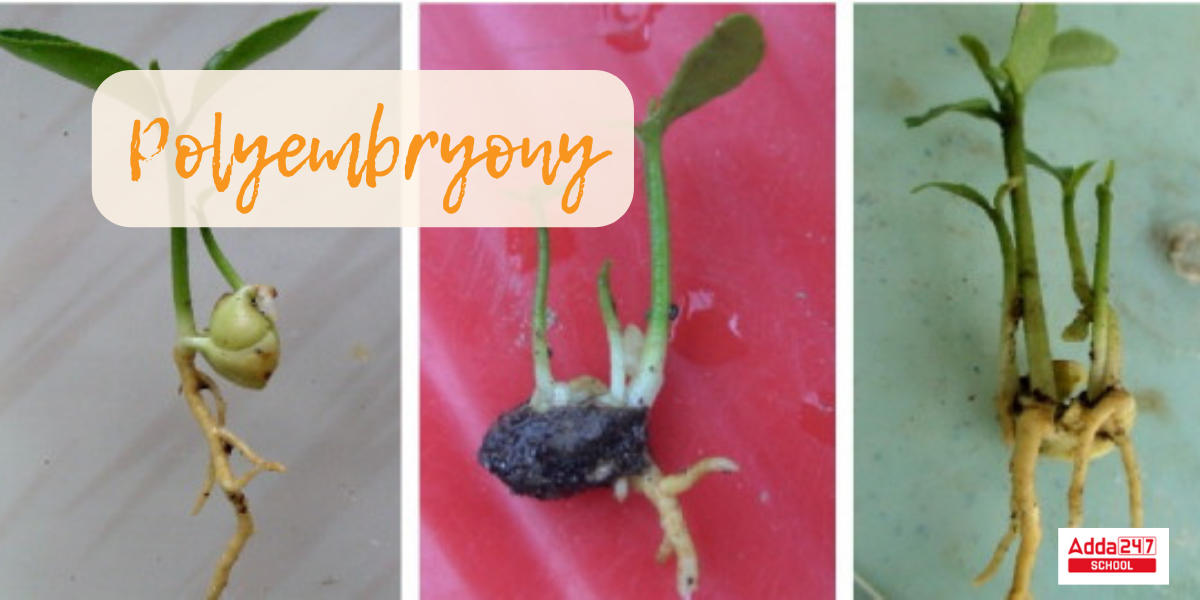Polyembryony: Polyembryony is the development of two or more embryos from a single fertilized egg. It occurs throughout animals’ and plants’ kingdoms. The Armadillo with nine belts is its biggest and most typical example of this characteristic, producing identical twins. It leads to the formation of two identical twins in the case of humans. This is a natural occurrence that occurs in both dicotyledons and monocotyledons. Polyembryony will be discussed in depth in this article, including Polyembryony types, examples, Polyembryony in Gymnosperm, Angiosperm, and more.
Polyembryony
Polyembryony is a condition that occurs when two or more embryos grow from a single fertilized egg. Polyembryony occurs often in many vertebrates, invertebrate, and plant species. Polyembryony is a typical phenomena in plants that happens when more than one embryos develop from a single fertilised egg. Because the embryos are derived from the same egg, they are identical to one another but genetically distinct from the parents. The genetic difference between children and parents, but sibling likeness, are important contrasts between polyembryony and the process of budding and ordinary sexual reproduction. If this occurs during human reproduction, it results in the delivery of identical twins.
What is Polyembryony in Plants?
Antoni van Leeuwenhoek in 1719 discovered polyembryony in plants, which is the production of more than one embryo from only one fertilised egg or seed. Polyembryony is so widespread among gymnosperms that it could be regarded as a defining characteristic of this group. It mainly happens in plants as a result of the fertilization of more than one embryonic sac or the origin of embryos from the embryonic sac. The female gametophyte generates two or more arches in most gymnosperms with polyembryony. Because each archegonium contains an egg, the existence of numerous archegonium results in the fertilisation of two or more eggs, leading to the development of two or more potential embryos.
Polyembryony Examples
As the term implies itself (poly-multiply), polyembryony refers to the occurrence of several embryos in a seed.
The seed is the embryonic development that later creates a plant. Polyembryony occurs when a seed produces more than one embryo that develops from an ovum. These are identical to one other but differ from their parents due to genetic differences.
Examples – Citrus fruits such as oranges, Opuntia, Argemone Mexicana, Ulmus Americana, Mangifera and others are polyembryony examples. The Polyembryony in orange fruit can be seen in the image below.
Polyembryony Diagram
This is the Polyembryony Diagram. please go through it.

Polyembryony in Citrus
Polyembryony is classified into two types. Polyembryony types can arise spontaneously or naturally, as well as experimentally.
- Polyembryony that has been induced experimentally thats called Induced Polyembryony.
- Polyembryony that occurs spontaneously thats called Spontaneous Polyembryony.
Spontaneous polyembryony is further classified into three types:
-
- Cleavage Polyembryony- Cleavage Polyembryony occurs when a fertilised egg generates several embryos. Cleavage Polyembryony is most common in gymnosperms.
- Made Polyembryony – So named because it is created by testing. In this situation, embryonic growth is regulated in the typical manner (a liquid or gel tailored to support microbial growth).
- Automatic Polyembryony – Polyembryony that happens naturally is known as automatic polyembryony.
Polyembryony was classified under three kinds by American botanist Herbert John Webber:
- Cleavage Polyembryony: Cleavage When an early embryo or zygote divides into two or more units, this is referred to as embryony. These units eventually develop into self-contained embryos.Only one fertilized egg can create several embryos in cleavage polyembryony. When an embryo divides into numerous identical sections, it has the potential to develop into a mature embryo. It is abundant in gymnosperms but uncommon in angiosperms. The zygote divides into two nuclei, resulting in four nuclei. Example –pinus
- Simple Polyembryony: This sort of polyembryony occurs when many archegonia are fertilised. The fertilisation of more than one egg or several archegonia (a haploid structure that generates female eggs) results in simple polyembryony. A Pinus specimen of Simple Polyembryony. Brassica has simple polyembryony.
- Rosette Polyembryony: Rosette cells in gymnosperms produced multiple embryos. Several more embryos are born from rosette cells produce this kind of polyembryony.
Polyembryony Types
Ernst (1918) and Schnarf (1929) distinguished two types of polyembryony.
True Polyembryony
True polyembryony is the most prevalent type of embryo development that results in the formation of a single embryo sac. The extra embryos are formed by cleaving a zygote or by antipodal cells and synergids.
False Polyembryony
When two or more embryos originate and develop into a monosporic embryo sac, this is known as false polyembryony. Two or more nucelli fuses are seen here for embryo sac formation.
Induced Polyembryony
Proembryo, zygote, or early sporophytic cells are not necessary for this type of polyembryony. A culture media can be used to produce an embryo. Somatic embryos or adventitious embryos are the names given to these induced embryos.
Polyembryony in Gymnosperm
Different gymnosperms exhibit various types of polyembryony. They are discussed below.
Cycadales Polyembryony –
- Polyembryony is a rare occurrence in Cycadales. However, Rao was the first to report the phenomena of simple polyembryony in Cycas Circinalis in 1964.
- This group occasionally exhibits Simple Polyembryony. A.N Rao discovered it in Cycas Circinalis. Two adjacent archegonia of the same ovule can develop independently producing two embryos and, in rare cases, two seedlings.
Texales (slow-growing, long-lived plants) Polyembryony –
- Simple Polyembryony arises in this group as a result of the fertilisation of several archegonia eggs.
- Taxus contains 16 nuclei prior to the formation of walls. The proembryo’s terminal tier may have multiple cells. Only one egg survives to maturity out of all the eggs. The suspensor cells are cleaved during the procedure.
- However, just one cell cuts the apical cell segment, giving it the upper hand over the others. Suspensor cell cleavage polyembryony also occurs here.
- English yew, Taxus Cuspidats, Pacific Yew, and other species are examples.
Coniferales Polyembryony –
- Polyembryony in Coniferales is characterised by simple polyembryony in nearly all of its members. The number of embryos here ranges from two to numerous.
- This classification includes both Simple and Cleavage Polyembryony. Pine, Tsuga, Sciadopitys, Cedrus, Sequoia, Thuja, Juniperus, and Podocarpus have all been found to have cleavage polyembryony. Both, though, are common. Pine, Cedrus, Tsuga, Sciadopitys, Sequoia, Thuja, Juniperus, and Podocarpus have all been found to have cleavage polyembryony. Both, however, are common in Cupressus.
Gnetales (very developed gymnosperms) Polyembryony –
- Polyembryony occurs in numerous ways in this group. Gnetum, a Gnetales genus, exhibits a high incidence of polyembryony.
- Each seed contains a number of zygotes and prothalli. Each primary suspensor tube may generate an embryo at its tip, leading in the production of many embryos.
- The embryonal mass at the leading edge of the secondary suspensor may multiply and give rise to more embryos. Secondary suspensor cells can sometimes become meristematic, resulting in a large number of embryos.
- Gnetum, Ephedrales, Melinjo, Gnetum Oblongum, and others are examples.
Polyembryony in Animal
Polyhedra causes people to have identical twins. The nine-banded armadillo is the best example of Polyembryony in the animal realm. This wild species gives birth to identical quadruplets and is a medium-sized animal found in some places of America. Creating what are regarded as identical twins in humans Among the parasitic insects of the order Hymenoptera, Copidosoma truncatellum, a parasite of certain cutworms, deposits a single egg in the body of the host worm from which up to 2,000 offspring might emerge.









 DTE Maharashtra Polytechnic Merit List 2...
DTE Maharashtra Polytechnic Merit List 2...
 JEECUP Round 2 Seat Allotment Result 202...
JEECUP Round 2 Seat Allotment Result 202...
 YCMOU Result 2025 Out @ycmou.digitaluniv...
YCMOU Result 2025 Out @ycmou.digitaluniv...









